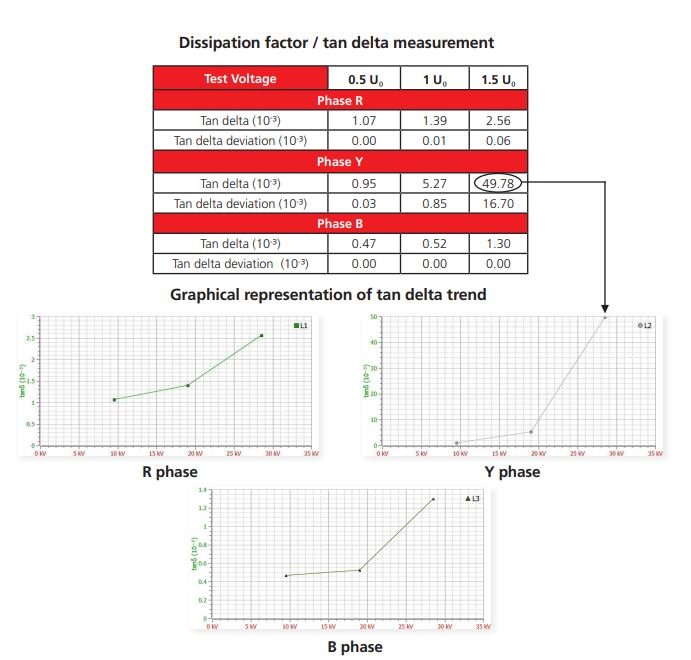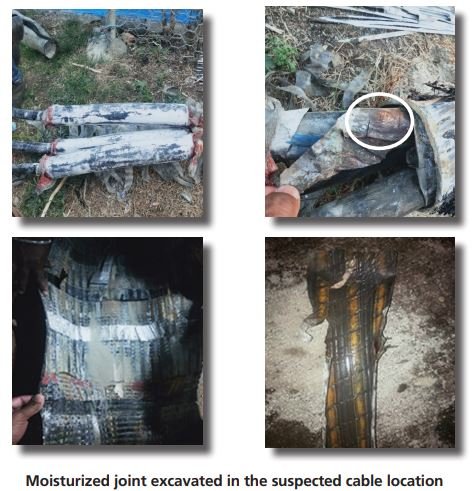One of the most respected power utilities in India carried out a cable condition assessment in two large 50 MW solar power plants in Karnataka, India. This decision was triggered by a previous major outage, which was caused by a simple cable failure. This cable failure resulted in a long outage time, resulting in huge economic losses as well as loss of income. Because of the remote location, it was hard to find a service provider that could quickly locate the cable fault, repair the cabl,e and commission the circuit.
As the high reliability of the MV network is critical, to reduce loss of revenue due to a power outage, the power utility decided to carry out a condition assessment on all MV cable circuits within the two solar power plants. The assessment included insulation resistance measurement (IR), dielectric absorption ratio (DAR), tan delta measurement (TD), and partial discharge analysis (PD). The work to carry out the condition assessment of the cable was awarded to Megger India, based on its technical knowledge and experience.

Summary of condition assessment activities:
From the 20 tested cable circuits, a total of 19 circuits were found in good condition, and periodic monitoring has been recommended to monitor their ageing over time. However, one circuit showed anomalies as TD and PD results were not within the tolerance level. For this specific cable, direct action was recommended.
The identified cable had a length of 1002 m. The IR and DAR values showed some differences between the phases when looking at the phase-to-ground resistance. The phase-to-phase values were stable, though. However, the TD diagnostics showed a large tip-up and an absolute value in the Y-phase. The other two phases had normal levels. Different TD values between phases often indicate a local problem, such as issues with a joint.


The above graphs show the TD trend for each individual phase. It can be observed that the Y phase has far higher values compared to the R and B phases, as the dielectric losses in the Y phase at 1.5 U₀ are 20 to 40 times higher. The results were compared with the evaluation criteria set out by the IEEE 400.2-2013. The recommendations suggested “No action required” for the R and B phases, but “Action required” for the Y phase.
As a local problem was indicated, it was recommended to either perform a withstand test or a PD test. A withstand test cannot guarantee that the local problem will be brought to a controlled breakdown; therefore, a PD test is the best option of the two.

The partial discharge measurement was carried out using Megger PD detector along with the VLF Sine 62, as seen in the image above. The following test voltages were applied to the cable: 0.2 U₀, 0.5 U₀, 0.8 U₀, 1 U₀, 1.2 U₀, 1.5 U₀ and 1.7 U₀. Specifically, for these local problems (or if an installation is in a wet environment), one should do the PD diagnostics longer than normal to give discharges a chance to ignite. No discharges were recognised up to 1 U₀ (phase-to-earth voltage), as shown in the graph below.

With increasing voltage over 1 U₀, PD’s were localised at the terminations. After analysing the PRPD pattern, this turned out to be corona discharges. Additionally, in the Y phase (which had high TD values) another PD location became visible and discharges were located at about 800 m away from the near end.

The customer wanted to confirm this location by performing PD diagnostics from the opposite end. The additional measurement confirmed the first findings.

Physical verification:
The power utility decided to take out the joint and carry out a further investigation. The final investigation concluded that the joint was not properly installed, and that moisture ingress had created the water trees. A few of the water trees have converted into electrical trees, which cause the Partial Discharge.

Summary:
Based on the first outage, which caused high revenue losses, a condition assessment was performed on all the MV cables within the solar power plant. From the 20 tested cables, 19 were found to be in good condition. Only one cable showed anomalies. The TD diagnosis confirmed this. The subsequent PD diagnostics pinpointed the fault.
With help from the condition assessment, the utility now has a good fingerprint of the complete MV network, and one highly degraded joint has been identified and replaced. This prevented the power utility from experiencing another outage, which could have caused additional high revenue losses. As the complete cable diagnostics work was carried out during the night, when the solar plant does not generate any power, the condition assessment program itself did not result in a loss of income.










